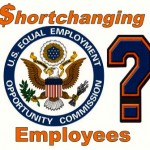 After the EEOC investigates claims of civil rights violations in the workplace, it either finds “reasonable cause” that illegal conduct has occurred or not. For those reasonable cause findings, the EEOC is legally required to engage in efforts to conciliate the charge – essentially attempt to resolve the matter – before it decides to close its file or to file suit. Specifically, the regulations provide that the EEOC has a duty to “attempt to resolve the complaint by informal methods of conference, conciliation and persuasion.” 29 CFR §1691.9.
After the EEOC investigates claims of civil rights violations in the workplace, it either finds “reasonable cause” that illegal conduct has occurred or not. For those reasonable cause findings, the EEOC is legally required to engage in efforts to conciliate the charge – essentially attempt to resolve the matter – before it decides to close its file or to file suit. Specifically, the regulations provide that the EEOC has a duty to “attempt to resolve the complaint by informal methods of conference, conciliation and persuasion.” 29 CFR §1691.9.
Unfortunately, there is no definition of what constitutes such “conciliation” efforts and the EEOC has long been criticized for engaging in “take it or leave” tactics at the conciliation stage. Earlier this month, a federal judge in New York joined in this chorus of criticism and sanctioned the EEOC for, among other things, “spurning [the employer’s] offer of conciliation and instead engaging in extensive discovery to develop the non-intervenor claims – already has and would further prejudice [the employer].”
In ordering the sanction against the EEOC, the judge noted she did not “impose this severe sanction lightly” and recognized that, as a result of the sanction, some of the employees who had meritorious claims would never “see the inside of a courtroom.”
Unfortunately, the employees impacted in the New York case by the judge’s sanction against the EEOC for its failure to engage in good faith conciliation efforts are not the only employees shortchanged by the EEOC’s “take it or leave it” conciliation tactics.
In 2012, for example, the EEOC found “reasonable cause” in approximately 9,425 claims, but closed 60% of those charges without any resolution or further litigation. Those individuals were left on their own.
Here is a chart I created using the data from the EEOC’s reported statistics for 2012. To create this chart, I pulled the number of reasonable cause findings and the number of successful conciliations from each of the EEOC’s charts on the different types of claims that can be brought under the laws enforced by the EEOC.
For example, according to the EEOC’s chart on charges filed and resolved under Title VII alleging race-based discrimination there were 1,179 reasonable cause findings in 2012 and 450 of those reasonable cause findings were successfully conciliated. Click here to review the EEOC’s chart on race-based discrimination charges. According to the EEOC’s webpage, the data for these charts “are compiled by the Office of Research, Information and Planning from data compiled from EEOC’s Charge Data System and, from FY 2004 forward, EEOC’s Integrated Mission System.”
EEOC Litigation Statistics for 2012
|
Number of Charges With “Reasonable Cause” Findings (Title VII, ADA, ADEA, EPA) |
Number of Successful Conciliations |
Number of Lawsuits Filed by EEOC |
Number of “Reasonable Cause” Findings where EEOC Took No Action |
|
9,425 |
3,485 |
155 |
5,785 |
This abandonment of employees by the EEOC is not unlike the larger child sitting behind the smaller child and helping the smaller, younger child learn to teeter-totter with another child on the other side. Suddenly, without warning, the larger child jumps off the teeter-totter leaving the smaller child – who’d been benefiting from the tandem-situation – into a tenuous situation where leverage cannot be found.
As I did in March 2013 in my testimony to the EEOC, I urge the EEOC to, at minimum, implement a pilot program incorporating a structured ADR process into the EEOC’s post-cause conciliation process.
If the EEOC continues to refuse to implement a structured conciliation process, I urge Congress to consider legislation that would do so. Continuing to fail to provide any meaningful support for 60% of employee claims found to have “reasonable cause” should be viewed as unacceptable by anyone’s metric.

Lorene, thank you for sharing these startling statistics. This failure to bring cases to closure is damaging to both employees and employers.
I am curious how State Commission Against Discrimination agencies fare in comparison. I have experience in both MA and CT, with various degrees of concilation success.
Lorene,
This is rapidly becoming a field I am doing significant work in NY in and the EEOC recently rejected to consider a matter my client believed they were a very good fit for. Thank you for this information.
Lorene,
I appreciate you having further illuminated the gap between reasonable cause findings and inaction, it takes a win-win to a no win.
Pingback: Court Rejects EEOC’s Argument that Its Conciliation Efforts Not Subject to Review | WinWinHR
Pingback: Court Rejects EEOC’s Argument that Its Conciliation Efforts Not Subject to Review
Pingback: Employment Law Blog Carnival: Haunted House Edition | Current Employment
Pingback: Employment Blawg Carnival - Haunted House Edition | WinWinHR
Pingback: EEOC’s Arguments to Supreme Court Antithesis of Transparency and Open Government | WinWinHR
Pingback: EEOC’s Arguments to Supreme Court Antithesis of Transparency and Open Government